Excel charts: Mastering pie charts, bar charts and more - keenanorned1982
Excel's chart features can turn your spreadsheet data into compelling visual communication theory—if you know what to do. This guide will walk you finished the basics of scope up trends, percentages, relationships, averages, and a good deal Thomas More. We'll proceed adding information over metre, so bookmarker this page to learn many.
Graph Designs
Excel has 16 chart designs with several models in each design, advantageous a dozen about styles, colours, and layouts for each model in from each one design. Reported to Microsoft, precise types of data are paired with the chart design that showcases that information best. When you select Recommended Charts from the Insert tab, Excel displays a visual list of the charts that would all but successfully represent your current dataset.
For instance, Column charts illustrate how data changes over time, but they'Re also the best design to show comparisons among items. Ginmill charts are, essentially, just horizontal Column charts and are generally used when the axis labels are exceptionally foresightful. Pie charts are put-upon to indicate percentages of the whole, and Line charts excel with data trends.
The left chart designs let in Area, Lineage, Surface, Jazz group, Pareto, Histogram, and Sunburst. For best results, avoid the following designs altogether: Radar, Bubble, XY/Scatter, Treemap, Waterfall, and Box seat & Whisker. These sestet graph designs are indeed difficult to read, they fail to explain the data to most viewers.
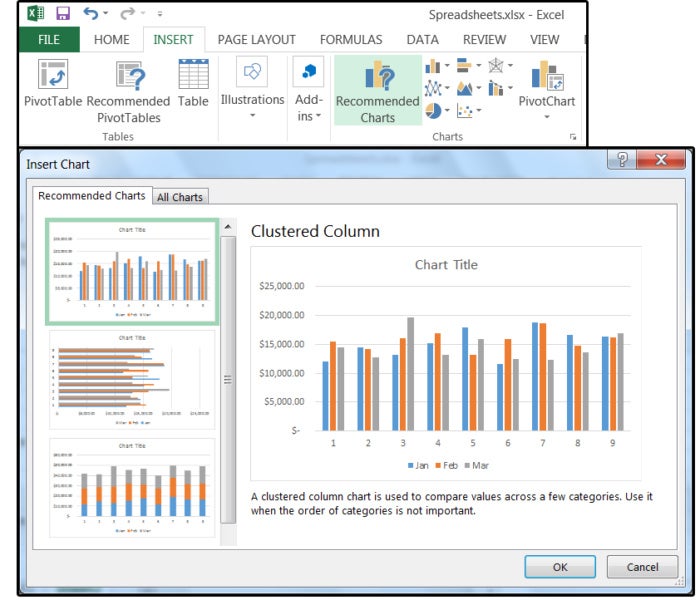 JD Sartain / Personal computer World
JD Sartain / Personal computer World Recommended Chart designs include the classic Column variety.
Chart Structure
Before we tackle individual chart designs and models, information technology's important to understand how charts are constructed. Unflurried from your databases, which contain fields (columns) and records (rows), charts are comprised of categories, which are generally aligned along the horizontal axis of rotation, and values (or data series), which align along the passant axis. Let's build a quick chart to demo how all the pieces function.
1. Highlight the columns and rows in your Excel database that you want to chart. In our object lesson (below), we highlighted columns B through D and rows 2 through 11 (the names of the months and the sales dollars of every month (that is, B2:D11).
2. Click Insert > Recommended Charts and prize a design from the Graph Name. For simplicity, choose the first design connected the tilt (the Clustered Column), then come home Oklahoma.
3. Excel drops the chart into the mid of the screen. Click the graph to activate it.
4. Position your cursor on one of the twice-lined borders and, when the cursor turns into a cross with arrow tips, hold down the left-wing sneak out button and get behind the chart to wherever you look-alike.
5. Observance the three icons happening the right side of the graph: Elements, Chart Styles, and Series/Categories.
6. With the chart is hand-picked, click the Green River plus sign and the Chart Elements menu pops up.
7. The Elements of the graph include the Axis and the Axis Titles (primary horizontal & semi-erect), the Chart Title, the Data Labels, Gridlines, the Legend, and a Trend line (with several options under each element).
8. Impediment or uncheck the boxes to aerate or inactivate the individual Elements.
9. Gyre down the list and notice the slender gray arrows that appear beside each element. Detent those arrows to open submenus with additional options for each component.
10. When you check the boxes for titles (axis and graph), you're prompted to typewrite your custom information for those titles. Enter those titles now.
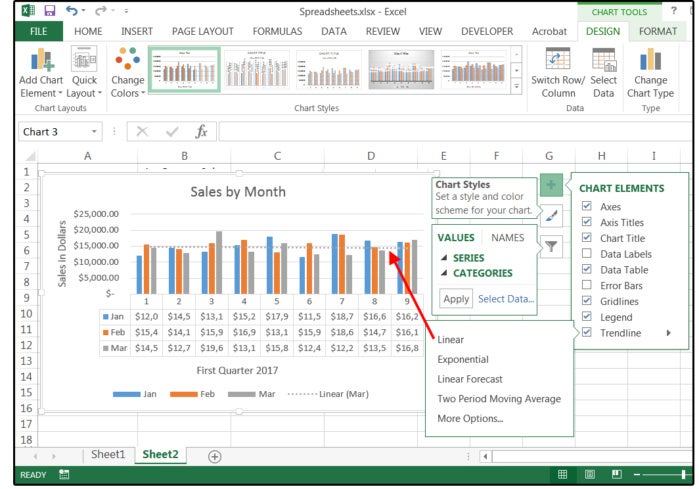 JD Sartain / PC World
JD Sartain / PC World Graph Elements
11. Click the paintbrush (Chart Styles) clit, and the Style and Color menu pops up. From this menu, you can change the conception styles and colours. You can also establish these changes through the Graph Tools menus.
12. When the chart is selected, two new tabs appear on the Ribbon fare: Chart Tools Design and Chart Tools Format. The Design computer menu also shows the Styles and Colors options, plus Graph Layout, the option to add Chart Elements, and several other features.
13. The Graph Tools Format tab is for the chart text, such as the titles and information labels. From this menu. you change the font typeface, color, size, style, and special personal effects. Or you can sink in the Format Selection image (far left) and open the menu, which includes the borders, take, conjunction, and school tex effects such as Shadow, Gleaming, Edges, and 3D Initialize.
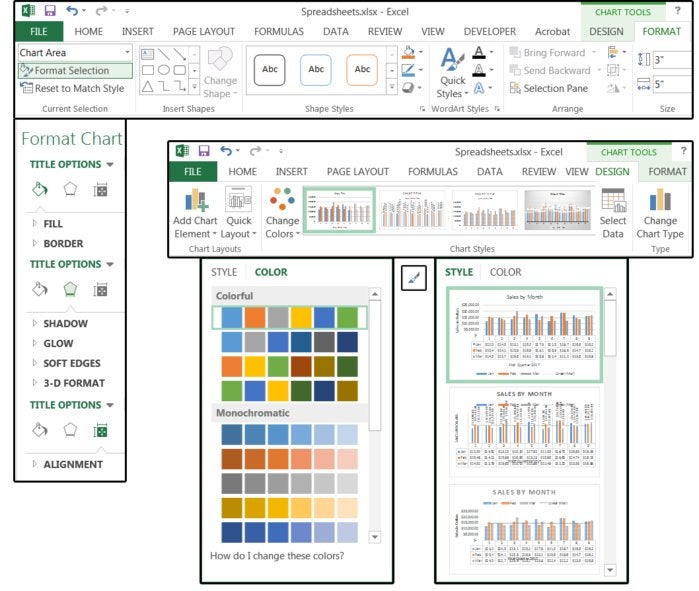 JD Sartain / Personal computer World
JD Sartain / Personal computer World Chart Tools Design and Format
14. You can besides access all of these features through the crosscut keys. Use the Altitude important to access the shortcut menu, which displays shortcut letters inside dim boxes.
Note the proper way to use shortcut keys. For example, to access the charts, type Alt-N-R. The hyphens designate this command as a consecutive combo keystroke. Put differently, exhort the Alt key and release; then crush the N and outlet; and then press the R and outlet.
15. With the chart notwithstandin elect, detent the funnel (Chart Filters) button, and the Values and Names menu pops up. Use the Values menu to panoram and/operating theater alter the Series (Jan, February, Mar) or Categories (from Iron Human being through and through Hopeless Widow woman). If you scroll down and hover complete any unique Series (such As Jan) or Category, notice that the other months/categories fade. If you uncheck any of the Series or Categories, only the checked items are charted. Click Apply when finished.
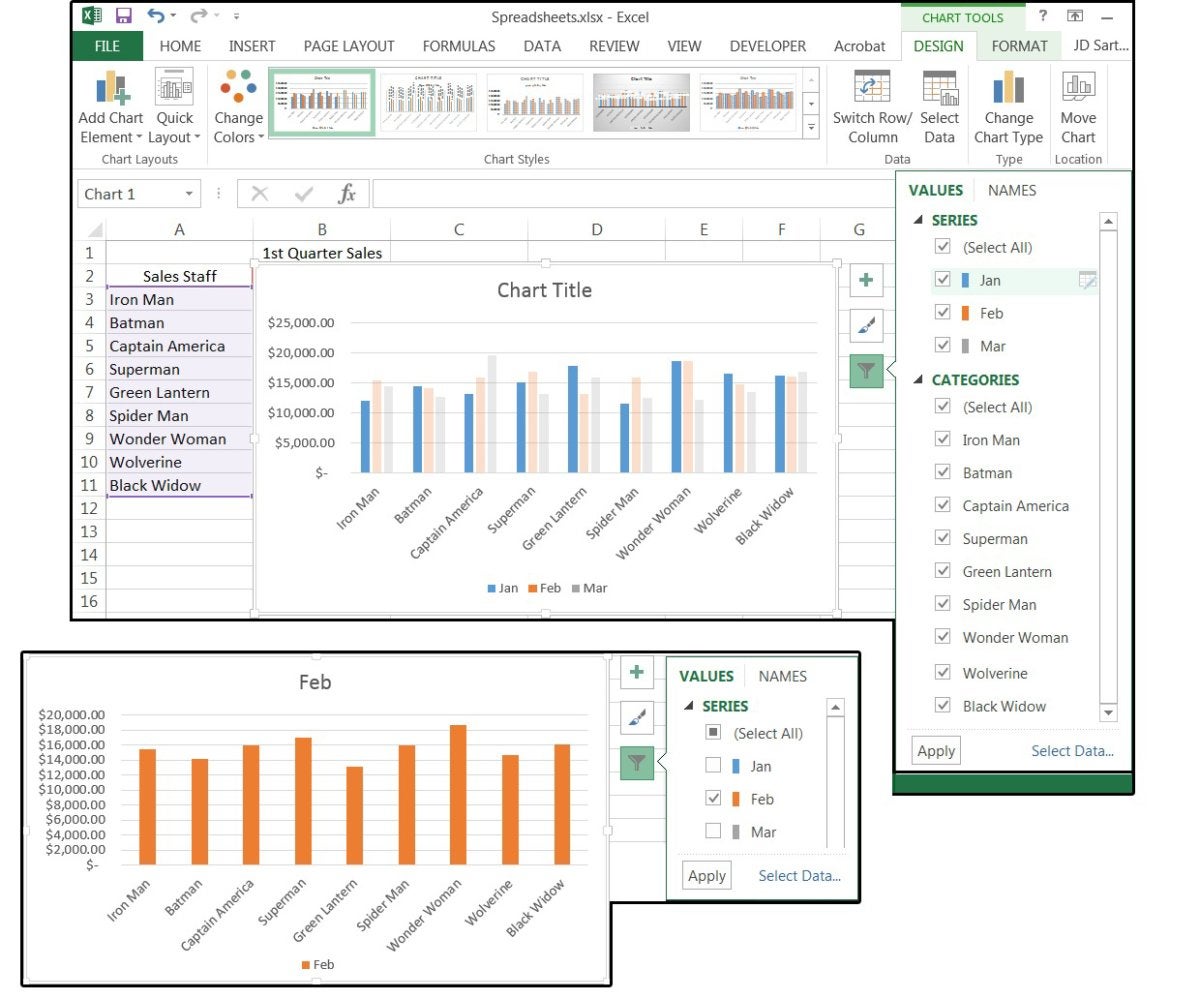 JD Sartain / PC World
JD Sartain / PC World Use the Chart Filters push button to filter Serial and Categories
16. Use the Names tab to change the names of the Series or Categories, Beaver State pick out No to get generic names such as Series 1, 2, 3 or Category 1, 2, 3, etc..
17. Click the Select Information link (bottom right corner) of the Chart Filters menu to alter (add, edit, remove) fields or records in your database. You can also exchange surgery exchange) the column data with the run-in data. For illustration, you can graph each employee's sales away calendar month. Or, you can switch the columns and rows and graph each month's gross revenue by employee (such as Jan gross sales for each employee).
This is a handy feature to use if, suddenly, your boss says, "Yea, but how do the employees' sales compare to one another each month?" As an alternative of reworking your spreadsheet or redesigning your chart, you can click indefinite button and totally change the way the charted data displays.
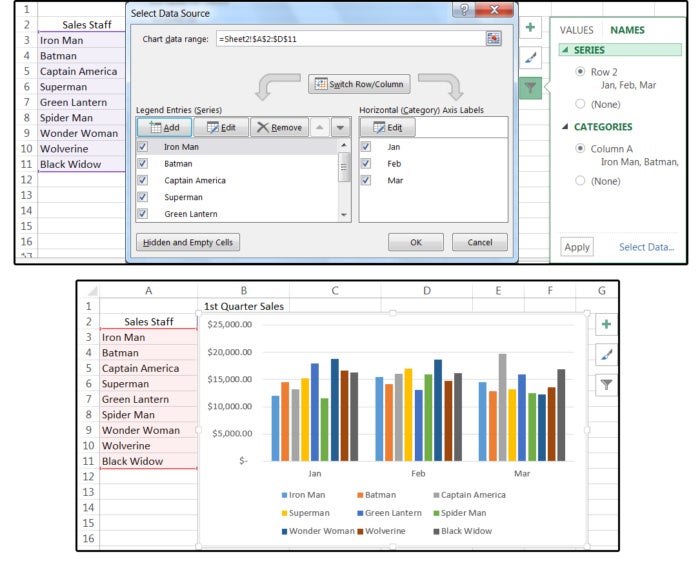 JD Sartain / Microcomputer World
JD Sartain / Microcomputer World Click the Pick out Data link to reverse the columns and rows
For this initial Charts piece, we'll cover the most popular and user friendly chart designs, including all the models inside all of those designs.
Tower & Saloon charts
Column and Bar charts are identical, leave out Columns are stand-up and Bars are horizontal. They're available in cardinal styles: Gregarious, Stacked, 100% Clustered, 3D Clustered, 3D Shapely, and 3D 100% Stacked. Column besides has one more: stark 3D style.
1. The Collective column/bar and 3D bunched tower/blockade charts are in 2D and 3D formats, respectively. Use these charts for scaled data (called the Likert Scale) much as those in use in polls. This chart is also useful for ranges of numbers or data and/or items that are non in any express order.
2. The Built column/barricade and 3D built pillar/banish also show values in 2D and 3D formats. This chart is incomparable for multiple information series with accentuated totals, or use information technology to break up and comparison parts of a uninjured (like a pie chart). IT's also effective for showing a grouped structure with a hierarchy that's one level deep.
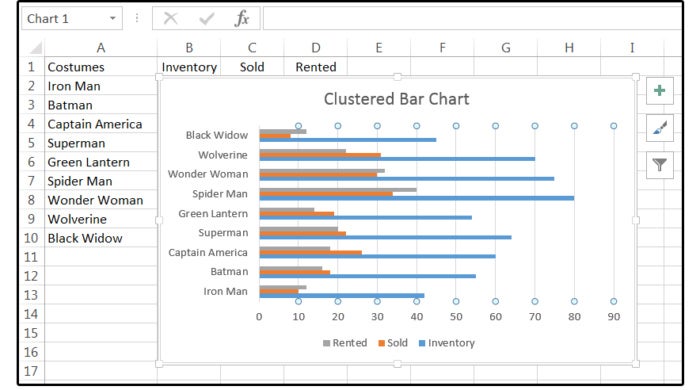 JD Sartain / PC World
JD Sartain / PC World Clustered Bar graph compares values across borderline categories.
3. Stacked column/bar and 3D well-stacked column/bar charts are particularly useful for comparison the percentages of each value in a total. This means that the cumulative pieces of each well-stacked element always equals 100 percent. Also, remark how pct values switch a period of time.
4. 3D column
The real plus for 3D charts—differently the obvious fact that they look much cooler than 2D charts—is the added welfare of three axes (horizontal, rearing, and depth), which you can change to able your information. Employment this chart to compare data across both categories and the data series.
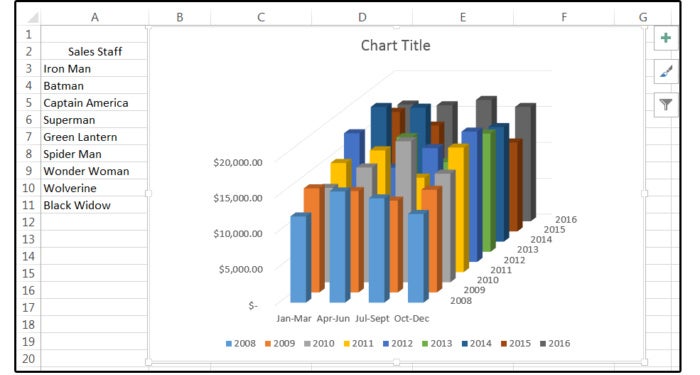 JD Sartain / PC World
JD Sartain / PC World The 3D Column chart has deuce-ac axes—horizontal, vertical, and depth.
Pie Charts
The Pie chart is constructed from a single row (Beaver State column) of data that represents a part of the whole (Proto-Indo European); or a uninominal column of numbers that, when added together, equal 100 percent. Operating theatre, to be more specific, the pie shows the size of items in one numeric series that's proportional to the sum of all the items.
Note: Pies can only chart one tower (or row) of positive numbers. Dissentient values cannot be charted, and zero values should be minimal (one or two upper limit). Last, the pie graph is limited to seven categories—that is, seven numbers that even the whole.
1. The Pie and 3D Proto-Indo European charts are, obviously, in 2D operating theatre 3D format, and slices backside be extracted for emphasis.
2. The Pie of Pie and Cake of PIE displays charts with smaller sections—of another pie or stacked bar graph—extracted from the full, again, for emphasis.
3. The Doughnut charts also conflate parts of a whole, but these charts can plot more than one column ordata series. The data is shown in rings, which each represent a data serial; and each series totals 100 percentage.
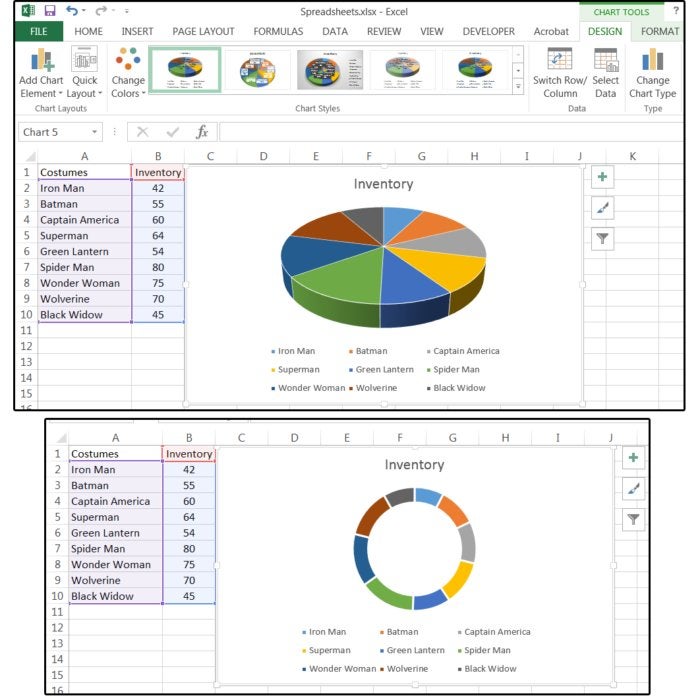 JD Sartain / PC World
JD Sartain / PC World 3D Proto-Indo European and Doughnut Charts
Line Charts
Line charts are pretty basic. The category info is dispersed (uniformly) on the horizontal axis, and the values are stacked equally on the vertical axis. Because these charts can exemplify continuous information, over time, on an equally scaled axis of rotation, the Line chart is perfect for showing trends that occur in equivalent intervals such as time (morning, noon, midnight, etc.), dates (months, quarters, years, etc.), cycles (of the moon, planets, stars, etc.), seasons (saltation, summer, autumn, winter), and so forth.
Function line charts when there are too many another information points to plot in the else graph designs (such as column, bar, pie, etc.). If the categories need to be in a specific rescript, use a trace chart as an alternative of a clustered column or clustered bar; however, the concentrated combo chart might work.
1. The Line of work and Line with markers charts show trends over time, evenly spaced categories, or information that must embody presented in a specific rate. For lots of categories or come close values, omit the markers.
 JD Sartain / PC Macrocosm
JD Sartain / PC Macrocosm Grassroots Line graph without markers
2. Stacked Line and Stacked Line with markers also show timely trends and evenly spaced categories.
3. 100% Shapely Transmission line and 100% Stacked Line with markers show per centum trends all over time or evenly leaded categories. Again, for lots of categories or approximate values, omit the markers.
4. 3D Line charts display to each one row/column of information every bit a 3D ribbon. Look-alike the other 3D charts, the 3D Business line chart has three axes (horizontal, vertical, and deepness) that can be altered.
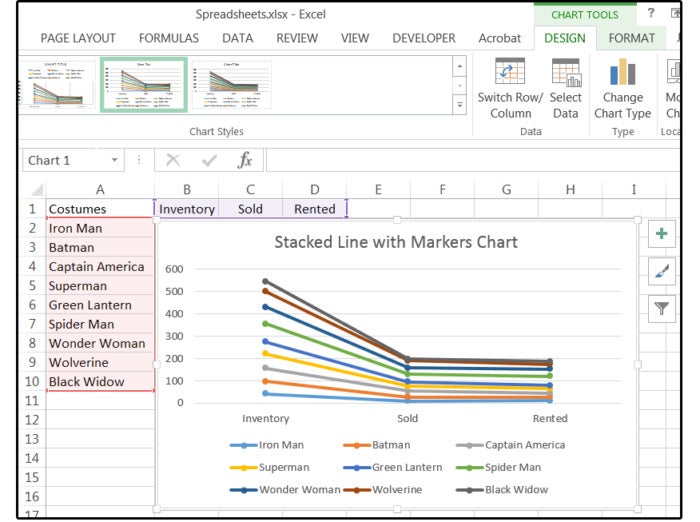 JD Sartain / PC World
JD Sartain / PC World Built Line Graph with markers
Source: https://www.pcworld.com/article/407369/excel-charts.html
Posted by: keenanorned1982.blogspot.com


0 Response to "Excel charts: Mastering pie charts, bar charts and more - keenanorned1982"
Post a Comment